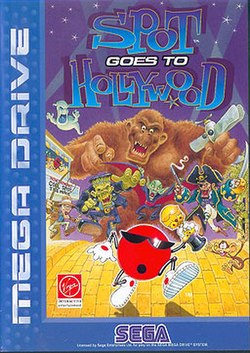Spot Goes To Hollywood
| Spot Goes to Hollywood | |
|---|---|

Cover art (Mega Drive)
|
|
| Developer(s) |
Eurocom (MD/GEN) Burst (SS, PS) |
| Publisher(s) |
Virgin Interactive (Saturn,PS, EU Megadrive) Acclaim Entertainment (Genesis NA) |
| Composer(s) |
Tommy Tallarico (MD/GEN) Keith Arem (SS, PS) |
| Platform(s) | Mega Drive/Genesis, Sega Saturn, PlayStation |
| Release |
Mega Drive/Genesis
|
| Genre(s) | Platformer |
| Mode(s) | Single-player |
| Review scores | |
|---|---|
| Publication | Score |
| EGM | 7.125/10 (GEN) |
| Next Generation |
|
Spot Goes to Hollywood is a platform video game released by Virgin Interactive for the Mega Drive/Genesis as the sequel to Cool Spot. A Sega Saturn and PlayStation version was later released, featuring different levels but similar gameplay to the original version. Sega 32X and SNES versions were also in development but got canceled before release. It utilizes an isometric graphics system to provide a pseudo-3D playing experience. The player controls Spot, once the mascot for the 7 Up soft drink, as he travels to various places trying to free his friends.
The central character in the game is Spot. Spot has become trapped in a movie projector. As he jumps from film to film, he encounters many classic film genres; these make up the various levels of the game. The main levels are a pirate movie, an adventure movie, and a horror movie, but there are many other bonus films to unlock.
Writing about the Genesis version, all four of Electronic Gaming Monthly's reviewers were impressed with the graphics and level design, and while one of them felt that the isometric perspective and controls make the game frustrating to the point of being unplayable, the other three felt that the difficulties presented by the perspective and controls actually enhance the experience. A reviewer for Next Generation also considered the graphics impressive and found the isometric perspective presented no difficulty at all due to the "diagonally oriented control method". He nonetheless concluded that "in a final analysis, the game offers only enough excitement to be considered average."GamePro gave it a negative review, complaining of the player character's slowness, the way the isometric perspective makes it difficult to judge where ledges are, the "average at best" graphics, and the poor sound effects.
...
Wikipedia
